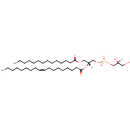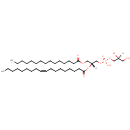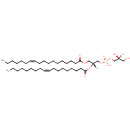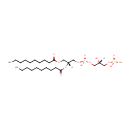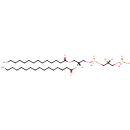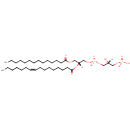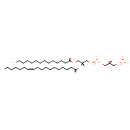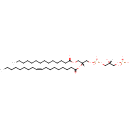
Search Results for compounds
Searching compounds for
returned 4373 results.
Displaying compounds 2451 - 2460 of
4373 in total
PG(18:1(9Z)/12:0) (PAMDB006393)
IUPAC:
[(2S)-2,3-dihydroxypropoxy][(2R)-3-(dodecanoyloxy)-2-[(9Z)-octadec-9-enoyloxy]propoxy]phosphinic acid
CAS: Not Available
Description: PG(18:1(9Z)/12:0) is a phosphatidylglycerol. Phosphatidylglycerols consist of a glycerol 3-phosphate backbone esterified to either saturated or unsaturated fatty acids on carbons 1 and 2. As is the case with diacylglycerols, phosphatidylglycerols can have many different combinations of fatty acids of varying lengths and saturation attached to the C-1 and C-2 positions. PG(18:1(9Z)/12:0), in particular, consists of one 9Z-octadecenoyl chain to the C-1 atom, and one dodecanoyl to the C-2 atom. In Pseudomonas aeruginosa glycerophospholipid metabolism, phosphatidylglycerol is formed from phosphatidic acid (1,2-diacyl-sn-glycerol 3-phosphate) by a sequence of enzymatic reactions that proceeds via two intermediates, cytidine diphosphate diacylglycerol (CDP-diacylglycerol) and phosphatidylglycerophosphate (PGP, a phosphorylated phosphatidylglycerol). Phosphatidylglycerols, along with CDP-diacylglycerol, also serve as precursor molecules for the synthesis of cardiolipin, a phospholipid found in membranes.
PG(18:1(9Z)/14:0) (PAMDB006394)
IUPAC:
[(2S)-2,3-dihydroxypropoxy][(2R)-2-[(9Z)-octadec-9-enoyloxy]-3-(tetradecanoyloxy)propoxy]phosphinic acid
CAS: Not Available
Description: PG(18:1(9Z)/14:0) is a phosphatidylglycerol. Phosphatidylglycerols consist of a glycerol 3-phosphate backbone esterified to either saturated or unsaturated fatty acids on carbons 1 and 2. As is the case with diacylglycerols, phosphatidylglycerols can have many different combinations of fatty acids of varying lengths and saturation attached to the C-1 and C-2 positions. PG(18:1(9Z)/14:0), in particular, consists of one 9Z-octadecenoyl chain to the C-1 atom, and one tetradecanoyl to the C-2 atom. In Pseudomonas aeruginosa glycerophospholipid metabolism, phosphatidylglycerol is formed from phosphatidic acid (1,2-diacyl-sn-glycerol 3-phosphate) by a sequence of enzymatic reactions that proceeds via two intermediates, cytidine diphosphate diacylglycerol (CDP-diacylglycerol) and phosphatidylglycerophosphate (PGP, a phosphorylated phosphatidylglycerol). Phosphatidylglycerols, along with CDP-diacylglycerol, also serve as precursor molecules for the synthesis of cardiolipin, a phospholipid found in membranes.
PG(18:1(9Z)/15:0) (PAMDB006395)
IUPAC:
[(2S)-2,3-dihydroxypropoxy][(2R)-2-[(9Z)-octadec-9-enoyloxy]-3-(pentadecanoyloxy)propoxy]phosphinic acid
CAS: Not Available
Description: PG(18:1(9Z)/15:0) is a phosphatidylglycerol. Phosphatidylglycerols consist of a glycerol 3-phosphate backbone esterified to either saturated or unsaturated fatty acids on carbons 1 and 2. As is the case with diacylglycerols, phosphatidylglycerols can have many different combinations of fatty acids of varying lengths and saturation attached to the C-1 and C-2 positions. PG(18:1(9Z)/15:0), in particular, consists of one 9Z-octadecenoyl chain to the C-1 atom, and one pentadecanoyl to the C-2 atom. In Pseudomonas aeruginosa glycerophospholipid metabolism, phosphatidylglycerol is formed from phosphatidic acid (1,2-diacyl-sn-glycerol 3-phosphate) by a sequence of enzymatic reactions that proceeds via two intermediates, cytidine diphosphate diacylglycerol (CDP-diacylglycerol) and phosphatidylglycerophosphate (PGP, a phosphorylated phosphatidylglycerol). Phosphatidylglycerols, along with CDP-diacylglycerol, also serve as precursor molecules for the synthesis of cardiolipin, a phospholipid found in membranes.
PG(18:1(9Z)/18:1(11Z)) (PAMDB006397)
IUPAC:
[(2S)-2,3-dihydroxypropoxy][(2R)-3-[(11Z)-octadec-11-enoyloxy]-2-[(9Z)-octadec-9-enoyloxy]propoxy]phosphinic acid
CAS: Not Available
Description: PG(18:1(9Z)/18:1(11Z)) is a phosphatidylglycerol. Phosphatidylglycerols consist of a glycerol 3-phosphate backbone esterified to either saturated or unsaturated fatty acids on carbons 1 and 2. As is the case with diacylglycerols, phosphatidylglycerols can have many different combinations of fatty acids of varying lengths and saturation attached to the C-1 and C-2 positions. PG(18:1(9Z)/18:1(11Z)), in particular, consists of one 9Z-octadecenoyl chain to the C-1 atom, and one 11Z-octadecenoyl to the C-2 atom. In Pseudomonas aeruginosa glycerophospholipid metabolism, phosphatidylglycerol is formed from phosphatidic acid (1,2-diacyl-sn-glycerol 3-phosphate) by a sequence of enzymatic reactions that proceeds via two intermediates, cytidine diphosphate diacylglycerol (CDP-diacylglycerol) and phosphatidylglycerophosphate (PGP, a phosphorylated phosphatidylglycerol). Phosphatidylglycerols, along with CDP-diacylglycerol, also serve as precursor molecules for the synthesis of cardiolipin, a phospholipid found in membranes.
PGP(10:0/10:0) (PAMDB006398)
IUPAC:
[(2R)-3-({[(2R)-2,3-bis(decanoyloxy)propoxy](hydroxy)phosphoryl}oxy)-2-hydroxypropoxy]phosphonic acid
CAS: Not Available
Description: PGP(10:0/10:0) belongs to the class of glycerophosphoglycerophosphates, also called phosphatidylglycerophosphates (PGPs). These lipids contain a common glycerophosphate skeleton linked to at least one fatty acyl chain and a glycero-3-phosphate moiety. As is the case with diacylglycerols, phosphatidylglycerophosphates can have many different combinations of fatty acids of varying lengths and saturation attached to the C-1 and C-2 positions. PGP(10:0/10:0), in particular, consists of two decanoyl chains at positions C-1 and C-2. In Pseudomonas aeruginosa, PGPs can be found in the cytoplasmic membrane. The are synthesized by the addition of glycerol 3-phosphate to a CDP-diacylglycerol. In turn, PGPs are dephosphorylated to Phosphatidylglycerols (PGs) by the enzyme Phosphatidylglycerophosphatase.
PGP(14:0/16:0) (PAMDB006399)
IUPAC:
[(2R)-3-({[(2R)-2-(hexadecanoyloxy)-3-(tetradecanoyloxy)propoxy](hydroxy)phosphoryl}oxy)-2-hydroxypropoxy]phosphonic acid
CAS: Not Available
Description: PGP(14:0/16:0) belongs to the class of glycerophosphoglycerophosphates, also called phosphatidylglycerophosphates (PGPs). These lipids contain a common glycerophosphate skeleton linked to at least one fatty acyl chain and a glycero-3-phosphate moiety. As is the case with diacylglycerols, phosphatidylglycerophosphates can have many different combinations of fatty acids of varying lengths and saturation attached to the C-1 and C-2 positions. PGP(14:0/16:0), in particular, consists of one tetradecanoyl chain to the C-1 atom, and one hexadecanoyl to the C-2 atom. In Pseudomonas aeruginosa, PGPs can be found in the cytoplasmic membrane. The are synthesized by the addition of glycerol 3-phosphate to a CDP-diacylglycerol. In turn, PGPs are dephosphorylated to Phosphatidylglycerols (PGs) by the enzyme Phosphatidylglycerophosphatase.
PGP(14:0/16:1(9Z)) (PAMDB006400)
IUPAC:
[(2R)-3-({[(2R)-2-[(9Z)-hexadec-9-enoyloxy]-3-(tetradecanoyloxy)propoxy](hydroxy)phosphoryl}oxy)-2-hydroxypropoxy]phosphonic acid
CAS: Not Available
Description: PGP(14:0/16:1(9Z)) belongs to the class of glycerophosphoglycerophosphates, also called phosphatidylglycerophosphates (PGPs). These lipids contain a common glycerophosphate skeleton linked to at least one fatty acyl chain and a glycero-3-phosphate moiety. As is the case with diacylglycerols, phosphatidylglycerophosphates can have many different combinations of fatty acids of varying lengths and saturation attached to the C-1 and C-2 positions. PGP(14:0/16:1(9Z)), in particular, consists of one tetradecanoyl chain to the C-1 atom, and one 9Z-hexadecenoyl to the C-2 atom. In Pseudomonas aeruginosa, PGPs can be found in the cytoplasmic membrane. The are synthesized by the addition of glycerol 3-phosphate to a CDP-diacylglycerol. In turn, PGPs are dephosphorylated to Phosphatidylglycerols (PGs) by the enzyme Phosphatidylglycerophosphatase.
PGP(14:0/17:0) (PAMDB006401)
IUPAC:
[(2R)-3-({[(2R)-2-(heptadecanoyloxy)-3-(tetradecanoyloxy)propoxy](hydroxy)phosphoryl}oxy)-2-hydroxypropoxy]phosphonic acid
CAS: Not Available
Description: PGP(14:0/17:0) belongs to the class of glycerophosphoglycerophosphates, also called phosphatidylglycerophosphates (PGPs). These lipids contain a common glycerophosphate skeleton linked to at least one fatty acyl chain and a glycero-3-phosphate moiety. As is the case with diacylglycerols, phosphatidylglycerophosphates can have many different combinations of fatty acids of varying lengths and saturation attached to the C-1 and C-2 positions. PGP(14:0/17:0), in particular, consists of one tetradecanoyl chain to the C-1 atom, and one heptadecanoyl to the C-2 atom. In Pseudomonas aeruginosa, PGPs can be found in the cytoplasmic membrane. The are synthesized by the addition of glycerol 3-phosphate to a CDP-diacylglycerol. In turn, PGPs are dephosphorylated to Phosphatidylglycerols (PGs) by the enzyme Phosphatidylglycerophosphatase.
PGP(14:0/18:1(11Z)) (PAMDB006402)
IUPAC:
[(2R)-2-hydroxy-3-({hydroxy[(2R)-2-[(11Z)-octadec-11-enoyloxy]-3-(tetradecanoyloxy)propoxy]phosphoryl}oxy)propoxy]phosphonic acid
CAS: Not Available
Description: PGP(14:0/18:1(11Z)) belongs to the class of glycerophosphoglycerophosphates, also called phosphatidylglycerophosphates (PGPs). These lipids contain a common glycerophosphate skeleton linked to at least one fatty acyl chain and a glycero-3-phosphate moiety. As is the case with diacylglycerols, phosphatidylglycerophosphates can have many different combinations of fatty acids of varying lengths and saturation attached to the C-1 and C-2 positions. PGP(14:0/18:1(11Z)), in particular, consists of one tetradecanoyl chain to the C-1 atom, and one 11Z-octadecenoyl to the C-2 atom. In Pseudomonas aeruginosa, PGPs can be found in the cytoplasmic membrane. The are synthesized by the addition of glycerol 3-phosphate to a CDP-diacylglycerol. In turn, PGPs are dephosphorylated to Phosphatidylglycerols (PGs) by the enzyme Phosphatidylglycerophosphatase.
PGP(14:0/18:1(9Z)) (PAMDB006403)
IUPAC:
[(2R)-2-hydroxy-3-({hydroxy[(2R)-2-[(9Z)-octadec-9-enoyloxy]-3-(tetradecanoyloxy)propoxy]phosphoryl}oxy)propoxy]phosphonic acid
CAS: Not Available
Description: PGP(14:0/18:1(9Z)) belongs to the class of glycerophosphoglycerophosphates, also called phosphatidylglycerophosphates (PGPs). These lipids contain a common glycerophosphate skeleton linked to at least one fatty acyl chain and a glycero-3-phosphate moiety. As is the case with diacylglycerols, phosphatidylglycerophosphates can have many different combinations of fatty acids of varying lengths and saturation attached to the C-1 and C-2 positions. PGP(14:0/18:1(9Z)), in particular, consists of one tetradecanoyl chain to the C-1 atom, and one 9Z-octadecenoyl to the C-2 atom. In Pseudomonas aeruginosa, PGPs can be found in the cytoplasmic membrane. The are synthesized by the addition of glycerol 3-phosphate to a CDP-diacylglycerol. In turn, PGPs are dephosphorylated to Phosphatidylglycerols (PGs) by the enzyme Phosphatidylglycerophosphatase.

